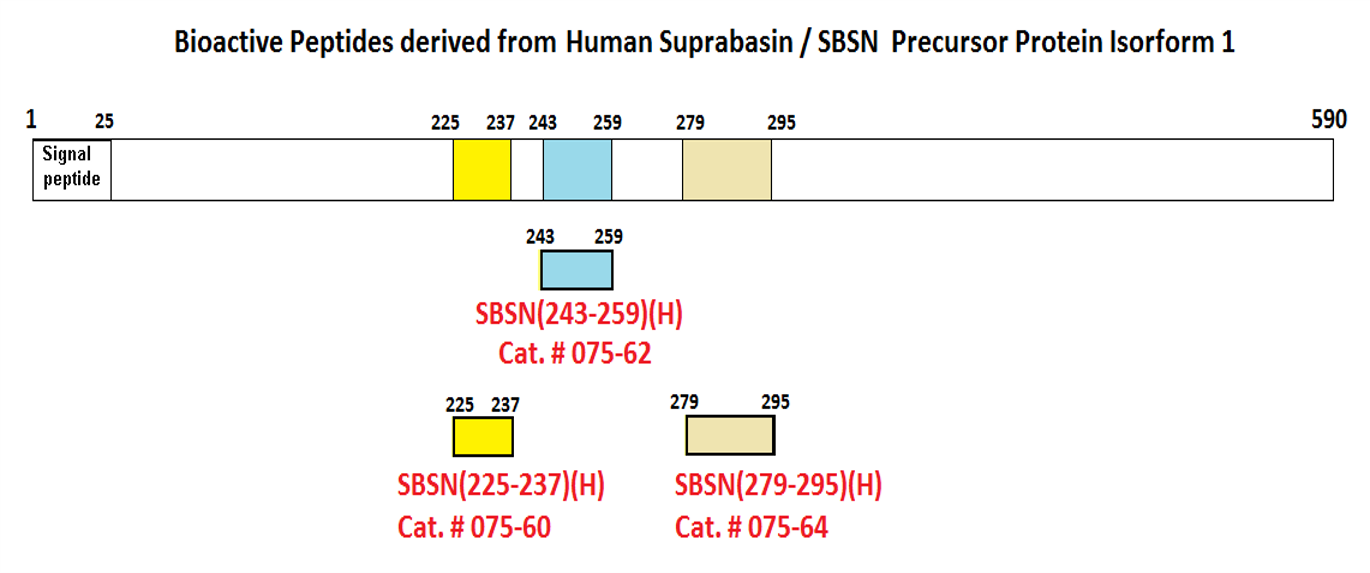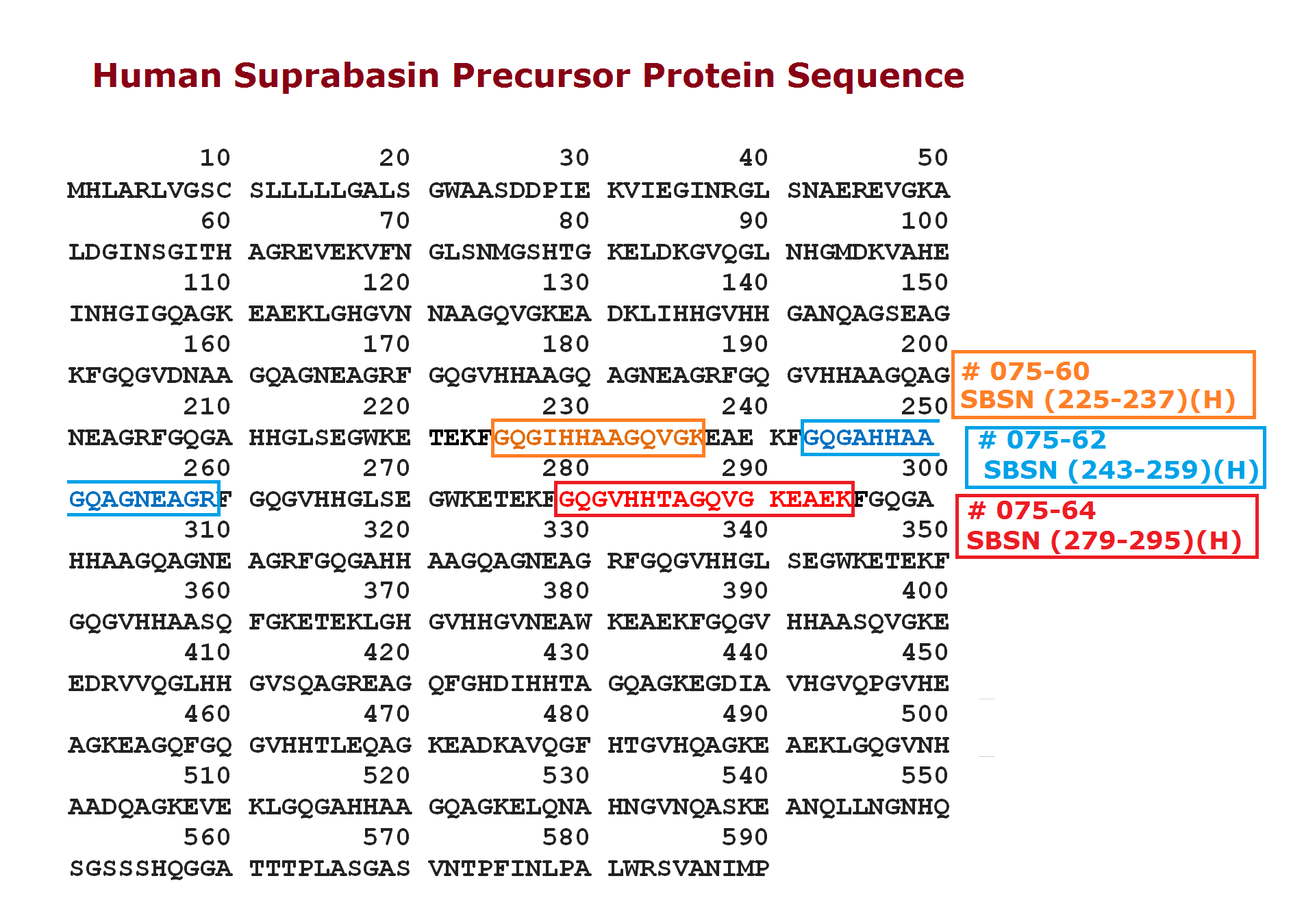Catalog # |
Size |
Price |
|
|---|---|---|---|
| 075-62 | 200 µg | $243 |
 )
)
|
Gly-Gln-Gly-Ala-His-His-Ala-Ala-Gly-Gln-Ala-Gly-Asn-Glu-Ala-Gly-Arg
|
| 1588.73 | |
|
| ≥ 95% |
|
| Exhibits correct molecular weight |
|
|
Up to 6 months in lyophilized form at 0-5ºC. For best results, rehydrate just before use. Aliquot before freezing to avoid repeated freeze-thaw cycles. |
|
| White powder |
|
| Each vial contains 200 μg of NET peptide. |


Abstract: Identification of low-abundance, low-molecular-weight native peptides using non-tryptic plasma has long remained an unmet challenge, leaving potential bioactive/biomarker peptides undiscovered. We have succeeded in efficiently removing high-abundance plasma proteins to enrich and comprehensively identify low-molecular-weight native peptides using mass spectrometry. Native peptide sequences were chemically synthesized and subsequent functional analyses resulted in the discovery of three novel bioactive polypeptides derived from an epidermal differentiation marker protein, suprabasin. SBSN_HUMAN[279–295] potently suppressed food/water intake and induced locomotor activity when injected intraperitoneally, while SBSN_HUMAN[225–237] and SBSN_HUMAN[243–259] stimulated the expression of proinflammatory cytokines via activation of NF-κB signaling in vascular cells. SBSN_HUMAN[225–237] and SBSN_HUMAN[279–295] immunoreactivities were present in almost all human organs analyzed, while immunoreactive SBSN_HUMAN[243–259] was abundant in the liver and pancreas. Human macrophages expressed the three suprabasin-derived peptides. This study illustrates a new approach for discovering unknown bioactive peptides in plasma via the generation of peptide libraries using a novel peptidomic strategy.
Taguchi T, Kodera Y, Oba K, et al. Suprabasin-derived bioactive peptides identified by plasma peptidomics. Sci Rep. 2021;11(1):1047.
Abstract: Radiation and chemotherapy represent standard-of-care cancer treatments. However, most patients eventually experience tumour recurrence, treatment failure and metastatic dissemination with fatal consequences. To elucidate the molecular mechanisms of resistance to radio- and chemotherapy, we exposed human cancer cell lines (HeLa, MCF-7 and DU145) to clinically relevant doses of 5-azacytidine or ionizing radiation and compared the transcript profiles of all surviving cell subpopulations, including low-adherent stem-like cells. Stress-mobilized low-adherent cell fractions differed from other survivors in terms of deregulation of hundreds of genes, including those involved in interferon response. Exposure of cancer cells to interferon-gamma but not interferon-beta resulted in the development of a heterogeneous, low-adherent fraction comprising not only apoptotic/necrotic cells but also live cells exhibiting active Notch signalling and expressing stem-cell markers. Chemical inhibition of mitogen-activated protein kinase/ERK kinase (MEK) or siRNA-mediated knockdown of extracellular signal-regulated kinase 1/2 (Erk1/2) and interferon responsible factor 1 (IRF1) prevented mobilization of the surviving low-adherent population, indicating that interferon-gamma-mediated loss of adhesion and anoikis resistance required an active Erk pathway interlinked with interferon signalling by transcription factor IRF1. Notably, a skin-specific protein suprabasin (SBSN), a recently identified oncoprotein, was among the top scoring genes upregulated in surviving low-adherent cancer cells induced by 5-azacytidine or irradiation. SBSN expression required the activity of the MEK/Erk pathway, and siRNA-mediated knockdown of SBSN suppressed the low-adherent fraction in irradiated, interferon-gamma- and 5-azacytidine-treated cells, respectively, implicating SBSN in genotoxic stress-induced phenotypic plasticity and stress resistance. Importantly, SBSN expression was observed in human clinical specimens of colon and ovarian carcinomas, as well as in circulating tumour cells and metastases of the 4T1 mouse model. The association of SBSN expression with progressive stages of cancer development indicates its role in cancer evolution and therapy resistance.
Hubackova S, Pribyl M, Kyjacova L, et al. Interferon?regulated suprabasin is essential for stress?induced stem?like cell conversion and therapy resistance of human malignancies. Mol Oncol. 2019;13(7):1467-1489.
No References
| Catalog# | Product | Size | Price | Buy Now |
|---|
Social Network Confirmation